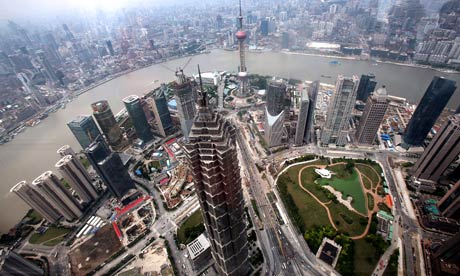Shifting foundations threaten to undermine China’s cities
Urban growth and depletion of groundwater blamed for land subsidence in Shanghai and elsewhere
- Guardian Weekly, Tuesday 3 April 2012 13.59 BST
- Article history

A crack in the tarmac on a road in the middle of the Pudong business district told Shanghai residents that the subsoil of their city was shifting. It was not so much the size of the rift – about eight metres long and only a few centimetres across – more its location that caused concern. It was at the foot of the Shanghai Tower project.
Due for completion in 2014, the tower will stand 632 metres high, and is just next to two other giants, the World Financial Centre and Jinmao Tower, rising, respectively, 492 and 420 metres into the air.
The appearance of cracks in the ground and the publication of photographs on blogs have fuelled questions in recent weeks. “The surface cracks, which were caused by a usual settlement of the foundation ditch, are in a controlled and safe state,” the Shanghai Tower Construction and Development Company said in a statement to the China Daily.
The problem of subsidence in Chinese cities is nevertheless very real. “The pressure exerted by skyscrapers is a minor cause,” says Li Qinfen, a researcher at the Shanghai Institute of Geological Survey. Excessive pumping of groundwater to service new urban developments is the key factor.
The crack in the road has rekindled an old story, which claims that Shanghai is gradually sinking. The centre of China’s business capital has subsided by 2.6 metres since 1921, when the first surveys were carried out. The city stands on the Yangtze river delta, which rests on a layer of sediment, consisting mainly of clay and about 300 metres thick. After studying data from various surveys Dr Jin-Chun Chai, a professor at Saga University in Japan, concluded in a scientific journal: “The field data shows that there is a strong correlation between the rate of net groundwater pumping and the rate of land subsidence.”
Shanghai’s average annual subsidence from 1921 to 1949 was 2.5cm, according to official data. With increasing depletion of groundwater reserves the rate rose to 10cm a year in 1957-61. From 1966 onwards measures to restrict underground pumping slowed this trend. But in the 1980s, as the economy was opened up, water depletion and subsidence resumed, according to Li.
Last October, a hole appeared suddenly on a street near the main railway station. Then on 9 March, a 7km stretch of high-speed rail line collapsed in Hubei province. The line was due to open to passenger traffic in May and trials were already under way. A director of the provincial railway construction bureau, Wang Zujian, blamed the “unique local geological structure”.
According to a recent study by the Institute of Geology and Geophysics, 50 fast-expanding cities are affected by this type of subsidence, mainly due to excessive use of groundwater. The rise in demand is due to people migrating to the cities, to changing patterns of consumption and industrial growth.
Since the People’s Republic was established in 1949, 79,000 sq km of land has subsided by more than 20cm, above all on the north China plain, in the central mining provinces (Shanxi and Shaanxi), and on the Yangtze delta, according to the authorities. A plan presented in February by the land and resources ministry aims to halt subsidence in all three critical areas by 2015 by limiting water withdrawal. The plan will be applied to the whole country in 2020.
Shanghai – doomed, according to some observers, to suffer a similar fate to Atlantis – has in fact already taken action to reverse the trend, injecting about 60,000 tonnes of water a year into its aquifers, according to the city council.
This story originally appeared in Le Monde
